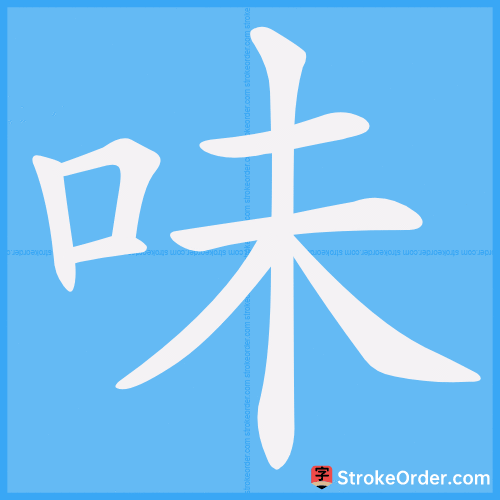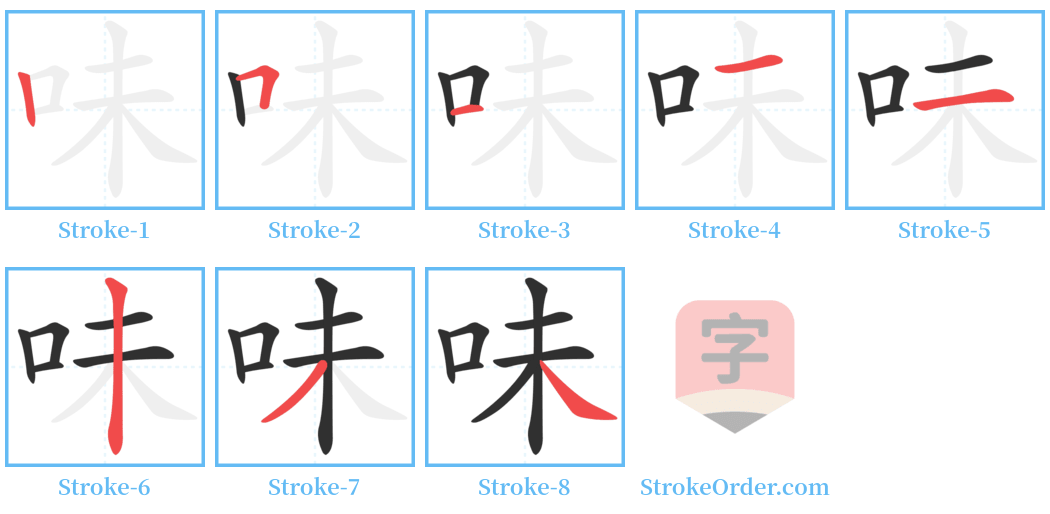味 Stroke Order
Animated Stroke Order of 味

Stroke Order Diagrams for 味

Step-by-Step Handwriting Guide for 味

Learn to Write Chinese Characters with Video Tutorials
Watch the video of writing the Chinese character "味", learn the correct stroke order (笔顺) of the character "味", and master the standard way of writing the character "味".
Free Printable Handwriting Practice with Stroke Order: 味
Printable Writing Practice Worksheet of "味" in Portrait Orientation (Tian Zi Ge)

Printable Writing Practice Worksheet of "味" in Landscape Orientation (Tian Zi Ge)

Information of 味
Pinyin
wèi
Radical
口
Strokes
8 strokes
Usage
★★★★★
Definition
taste
味 [wèi]
1. The sensation obtained from tasting something with the tongue.
舌头尝东西所得到的感觉。
2. The sensation obtained from smelling something with the nose.
鼻子闻东西所得到的感觉。
3. Interest and charm.
情趣。
4. Insight or research.
体会,研究。
5. A measure word, referring to a type of traditional Chinese medicine.
量词,指中草药的一种。
---
1. Sensation obtained from tasting: 口味, 滋味.
舌头尝东西所得到的感觉:~觉。~道(亦指兴趣)。滋~。
2. Sensation obtained from smelling: aroma.
鼻子闻东西所得到的感觉:气~。香~儿。
3. Interest and charm: 趣味; 兴味; 意趣.
情趣:趣~。兴~。意~。津津有~。
4. Insight or research: understanding.
体会,研究:体~。耐人寻~。
5. A measure word, referring to a type of traditional Chinese medicine: 五~药.
量词,指中草药的一种:五~药。
---
名 (noun)
- Original meaning: taste.
【本义】:滋味。
- Word formation: phonetic-ideographic character, composed of the mouth radical and the sound component '未'.
【造字法】:形声。从口,未声。
- 1. Same as the original meaning ([En.] taste).
同本义 ([En.] taste).
- 2. Food ([En.] food).
食物 ([En.] food).
- 3. Savor; experience ([En.] savor).
体味;体会 ([En.] savor)。
- 4. Buddhist term: one of the six sensory pleasures ([En.] one of sensual pleasure).
佛教语。六尘之一 ([En.] one of sensual pleasure)。
- 5. Tone or meaning ([En.] tone).
旨趣;意义 ([En.] tone)。
- 6. Smell or odor ([En.] smell; odor).
气味 ([En.] smell;odor)。
---
动 (verb)
1. To distinguish flavors; to taste ([En.] distinguish the flavor of).
辨别滋味;品尝 ([En.] distinguish the flavour of)。
2. To study by diligently reading, thinking, observing, and experimenting ([En.] study).
用心通过阅读和思考、观察和实验求得知识 ([En.] study)。
---
量 (measure word)
- Used as a term for a certain type of medicinal substance in traditional Chinese medicine.
——用于中药配方药物的一种为一味。
---
引 (references)
1. "说文": Taste refers to flavor.
《说文》:味,滋味也。
2. "周礼·疾医": Use five flavors, five grains, and five medicines to nourish illnesses.
《周礼·疾医》:以五味五谷五药养其病。
3. "鹖冠子·泰录": Taste is the origin of aromas.
《鹖冠子·泰录》:味者,气之父母也。
4. "礼记·礼运": Five tastes and six harmonies.
《礼记·礼运》:五味六和十二食。
5. "吕氏春秋·察今": The flavor of a pot.
《吕氏春秋·察今》:一镬之味。
6. Ming Dynasty, Liu Ji: All flavors are bitter.
明· 刘基《诚意伯刘文成公文集》:其味皆苦。
7. Taste is also bitter.
味亦苦。
8. The taste is bitter with a hint of spiciness.
味苦而微辛。
---
例 (examples)
- As in: The taste is like chewing wax (metaphorical for poetry or writing that is dry and unpleasurable).
又如:味如嚼蜡(比喻诗文枯燥,读后令人心情不舒)。
- To be flavorful: 有所滋味.
入味(有滋味)。
- Appetite: Refers to the desire for food.
味口(犹胃口。指食欲)。
- Taste for delicacies: A fondness for delicious food.
味欲(对美味的嗜好)。
- Flavor of food: The taste of dishes.
口味(饮食品的滋味)。
---
Please let me know if there is anything else I can assist you with!
to sample / to taste / to appreciate / one's taste (i.e. in music, literature, fashion, food and drink etc) / good taste
Input Method for 味
Pinyin
wei4
Wubi
kfiy|kfy
Cangjie
rjd
Zhengma
jbko
Four Corner
65090
Unicode
U+5473
Same Pronunciation Characters